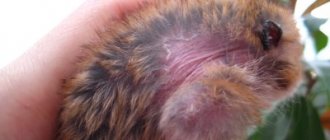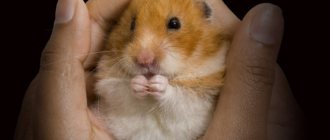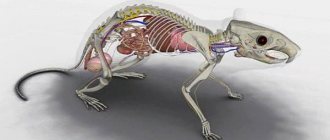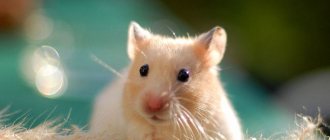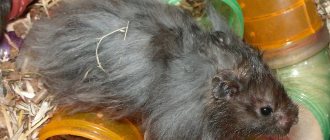Additional symptoms of a wet tail
The danger in hamsters lies in the long incubation period - up to 14 days. At this time, the pet continues to lead a normal life without any signs of illness, but he himself begins to infect other individuals.
After this time, the animal’s entire rear part, including the tail, becomes wet. Added to this are other serious symptoms:
Liquid feces The pet stains the entire cage with watery feces with a fetid odor; their color can be black or brown with impurities of blood.
Loss of appetite. The hamster refuses to eat and drinks little. When you try to force-feed your pet liquid food through a syringe, stomach upset increases.
Decreased activity. A sick animal moves little, sleeps almost all the time and does not react to stimuli. If he tries to walk around the cage, his paws tremble and move in different directions.
Discharge. A slimy transparent secretion flows from the nose, eyes and genitals.
Severe diarrhea in a hamster will lead to dehydration. To confirm, the owner can gently pinch a fold of the pet's skin between their fingers. It will not immediately smooth out, but will remain convex for some time.
Traditional methods of treatment
Traditional methods can be quite effective in treating human diseases, but with animals the situation is different. Not all recipes that help people are suitable for animals, so you need to be very careful. If you are sick, it is better to consult a veterinarian, but if this is not possible, then you can try using a decoction of grain crops (barley and oats are most often used). This remedy will help stop the diarrhea, and then there should be enough time to take the patient to a veterinary clinic. Traditional methods are aimed at eliminating symptoms and gaining time, and not at fighting the cause.
Pathogens
The cause of the appearance of a wet tail and other accompanying symptoms is the penetration of gram-negative bacteria Campylobacter and Lawsonia intracellularis into the hamster's body.
In veterinary medicine, the disease caused by these bacteria is called proliferative ileitis. The main routes of transmission are contaminated food and feces. However, not all infected individuals show symptoms.
A pet with a strong immune system can cope with pathogenic bacteria on its own, quickly eliminating the consequences of their vital activity. Weak individuals risk dying from body intoxication and dehydration. This outcome also awaits hamsters who are in a cramped or overcrowded cage without proper hygienic care.
Diagnostics
To make a diagnosis, the veterinarian will base the diagnosis on a combination of all the signs of a wet tail. A clear clinical picture makes it possible to prescribe treatment.
If the breeder has a large number of individuals, then you can try to make an accurate diagnosis using laboratory tests. This is necessary not only to save one pet, but also to take measures to protect other individuals.
For diagnostic purposes, secretions - feces, saliva - are collected from the infected animal. The resulting material is placed in a nutrient medium and, after the bacteria multiply, it is studied under a microscope.
Thus, Campylobacter can be detected, whereas Lawsonia intracellularis, due to its inability to live outside the cells of the host organism, cannot be detected.
To collect statistical data, the veterinarian may conduct tests for the presence of antibodies to gram-negative bacteria at the onset of the disease and after recovery. For the same purpose, the body of a hamster after death is studied through an autopsy.
The activity of bacteria leads to thickening and inflammation of the small intestine and enlargement of the lymph nodes of the abdominal cavity. In the intestines there is a viscous yellow liquid interspersed with blood.
Treatment
The regimen is prescribed by a veterinarian after determining the clinical manifestations. Most often used:
Antibiotics. Baytril – 0.5% solution for injection. The active ingredient is enrofloxacin. In the instructions for the drug, the dosage is 0.4 ml per 1 kg of weight.
It is impossible to calculate it for a hamster yourself. The course of treatment is 7-14 days.
Probiotics. Emprobio, Bifitrilak, Lactoferon. The preparations contain beneficial bacteria and their metabolic products. They are necessary to restore the balance of intestinal microflora and stimulate the production of antibodies.
The dose for an individual weighing 45-50 g is 0.1 ml. Probiotics should be given to the animal in diluted form - food, pure liquid.
Solutions for correcting water balance disorders. A dehydrated individual requires hydration therapy. It is carried out by a veterinarian, giving intra-abdominal and subcutaneous injections with Ringer's lactate, saline and glucose.
To generally strengthen and maintain body functions, the hamster is added to the diet with ascorbic acid and Catozal, which accelerates metabolic processes at the cellular level.
Metabolic disorders
Metabolism is the proper functioning of all body systems. Food processing, energy production, removal of unnecessary and harmful products. The central nervous system is responsible for all this, but the glands that secrete hormones have a huge influence on metabolic processes. These include the thyroid and pancreas, adrenal glands, pituitary gland, and gonads.
Diabetes mellitus can develop due to excessive consumption of carbohydrates. Hereditary predisposition to the disease also plays a role. You can find out that a hamster has contracted this disease by the characteristic smell of acetone, which comes from the rodent's saliva and urine. But only a doctor can make a final diagnosis by doing a blood test. Prevention of disease in Djungarian hamsters is a balanced diet, eliminating sugar from the diet, good care and an active lifestyle.
Stroke can also be classified as a disease that occurs due to metabolic disorders. With age and as a result of poor nutrition, cholesterol plaques are deposited on the walls of blood vessels, which prevent the normal passage of blood. At some point, the plaques completely block the vessel, it bursts, and hemorrhage occurs.
If your hamster is shaking or having convulsions, the end is probably near.
Sometimes attentive owners are concerned that the rodent has a yellow sore on its stomach. In fact, this is a scent gland, with the help of which the male marks his territory.
Features of care
At the first suspicion of infection, a sick hamster must be separated from other individuals. They should also be temporarily moved to a separate cage, and the previous one should be disinfected. Any chlorine-containing solution is suitable for this purpose.
After treatment, the rodents' house should be thoroughly rinsed with clean water. All installed equipment – toys, feeders, drinking bowls – also require disinfection.
The cage of a sick individual should always be dry and warm. The temperature in the room is 21-26°C without drafts. Carry out daily cleaning with changing bedding.
All hygiene measures must be carried out with gloves, since bacteria can pass through the owner’s hands to healthy animals. During the period of treatment and recovery, vegetables and fruits should be excluded from the hamster’s diet. It is better to offer your pet grain food - wheat, oats, rye.
Why does infection occur?
The causative agent is an intestinal bacterium that spreads from a sick animal to healthy individuals, therefore, if the disease is suspected, quarantine is necessary. Poor-quality food stored without the necessary conditions, dirty water, wet and dirty bedding - this is a favorable environment for the development of infection.
Did you know? North American hamsters, like magpies, drag everything that glitters into their burrows, often stealing various objects from people.
Prevention
To prevent infection of the hamster family with proliferative ileitis, the following rules should be followed:
- A new individual must be quarantined for 14 days.
- Buy a hamster only from trusted breeders.
- Adjust the diet based on the advice of your veterinarian.
- Choose natural food without chemical additives.
- Clean the cage every day. Pet hygiene procedures – once a week.
- Disinfection of housing and equipment - every 14 days.
- Eliminate stressful situations and fear of the animal.
Some breeders add antibiotics to the water for preventive purposes. But this is absolutely impossible to do, because such drugs do not protect against infection, but will only distort the clinical picture of the disease.
In addition, antibiotics disrupt the gastrointestinal tract, which in itself can lead to a wet tail in your pet due to diarrhea.
Worm infestation
Furry animals, like any other, are at risk of becoming infected with intestinal parasites. This is an unpleasant disease, but it is curable. Common types of internal parasites are tapeworms and roundworms. Their habitat is the intestines. Simple rules will ensure your pet is protected from worms:
- Maintain the correct feeding regimen.
- Choose only proven food.
- Avoid contact with infected animals.
Most often the disease is asymptomatic. But an attentive owner will definitely notice changes in the behavior and condition of the animal. Wet, greasy hair, weight loss with increased appetite, and upset bowel movements indicate the presence of parasites. You can treat helminthic infestation at home. It is not necessary to involve a doctor in this. To get rid of it, a course of deworming medications is enough. Choose medications that are specifically designed for rodents.
Which breeds are most susceptible to this disease?
The phenomenon is typical for all breeds of rodents due to the special structure of the gastrointestinal tract. But according to statistics, Syrian hamsters have a slightly higher percentage of infection due to their long hair, which is more difficult to clean from contamination.
In this case, individuals under the age of 12 weeks most often become ill. They have not yet sufficiently acquired the skill of cleaning their own wool and do not do it very carefully. This is also typical for older hamsters; in their case, the daily washing ritual takes a lot of energy.
The difference between wet tail and diarrhea – when to sound the alarm?
An inexperienced breeder most often fails to figure out in time what happened to his pet. Only 2-3 days pass from the appearance of a “wet tail” to the death of the rodent.
Therefore, it is very important to monitor your patients and understand what is happening to their health.
So, if a hamster has a wet backside, and he is actively playing, cleaning his fur, and eating, then most likely it is just diarrhea. But the reasons for its appearance should also be found out; maybe the food is not suitable for the animal or there is an excess of watery food in the diet.
You should go for a consultation with a veterinarian and begin active treatment if the hamster behaves aggressively on the first day of the “wet tail”. At the same time, such activity sharply changes to passivity, and he stops responding to any attempts to stir him up.
The animal mostly sleeps restlessly, its fur looks unkempt.
Hair loss and other diseases of hamsters
Hamsters are also susceptible to fungal and parasitic diseases. Most often they affect the pet's fur. Baldness, wounds from scratching, weeping spots on the skin, crusts are signs of a hamster illness.
When examining a sick hamster, be sure to wear gloves and follow safety precautions. Some diseases, such as shingles, can be transmitted from pets to humans. Treatment is carried out with antifungal drugs. If your pet scratches the skin so that the wounds become infected, the doctor will recommend external antibacterial ointments.
Scabies caused by mites is treated with antiparasitic medications. It is important to thoroughly disinfect the cage.
When fed only prepared diets, without adding greens, hamsters develop vitamin deficiency. It manifests itself in partial baldness. After adding green food to the menu, the pet’s condition returns to normal.
Parasites such as lice and lice eaters are rare in hamsters. Sometimes other pets (cat or dog) can “reward” the hamster with fleas. In this case, it is necessary to treat all pets. Unless otherwise advised by your veterinarian, drops or kitten spray are used for hamsters. It is necessary to recalculate the dosage taking into account the weight of the pet. The drops are applied to a cotton swab and then wiped over the pet’s withers. After 2 weeks, the treatment is repeated. Disinfection of the cage is mandatory.
But the dark spots on the sides of the animal are not a disease, but the consequences of excessive pigmentation.
Other problems that lead to wet tail
There are many factors that cause the fur around a rodent's anus to become wet. The main ones.
Poor nutrition
Hamsters' favorite treats are fruits and greens. They will rarely refuse an extra piece of apple, pear or banana.
But their excess in the diet will lead to diarrhea. Therefore, fruits should become a delicacy for rodents as a reward.
Poor hygiene
Lack of proper care undermines the pet's gastrointestinal tract and weakens its immunity. The hamster is constantly in contact with dirty and wet sawdust, drinking bowls and food bowls, and a place to rest.
If the cage is not cleaned for a long time, a large amount of dried food and feces accumulates at its bottom.
Gastrointestinal problems
Wet tail appears in hamsters even without bacterial infection. This occurs due to an imbalance of intestinal microflora, when one type of microorganism predominates over another. Once the balance between them is restored, the pet’s health will improve.
Stress
Representatives of the Khomyakov family tend to get scared and fall into melancholy. They experience stress after parting with their mother, moving to a new cage, or living with a large number of relatives. Even loud noises will cause stomach upset.
Gynecological problems
In young females after childbirth and old individuals, pathologies in the reproductive system, in addition to a wet tail, are accompanied by:
- bleeding;
- brown-yellow discharge with a strong unpleasant odor;
- bloating;
- protrusion of the vagina outward.
The listed symptoms may be a consequence of the presence of tumors and infections in the genitals or injury during childbirth.
Urinary tract infections
Old hamsters are susceptible to infection of the urinary system by pathogenic and fungus-like bacteria.
They experience a change in urine, it becomes yellow-green with a putrid odor and interspersed with blood clots. A sick hamster drinks a lot and relieves itself, gets tired quickly, and its fur is disheveled.
The prognosis for the recovery of a pet with a wet tail largely depends on how quickly the owner gets to the veterinarian. After all, proliferative ileitis is a disease of rapid development, and delay will lead to the death of a cute rodent. The sooner treatment begins, the greater the chance of saving your pet’s life.
Great article 1
